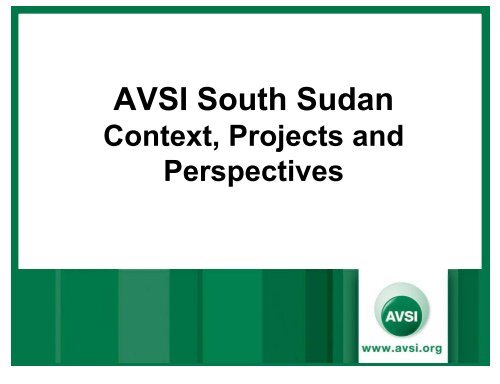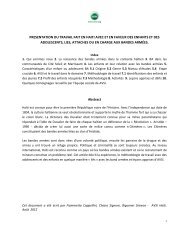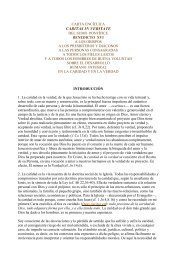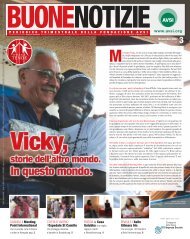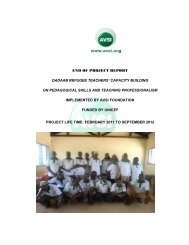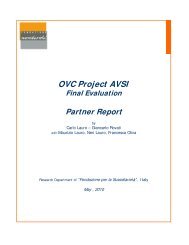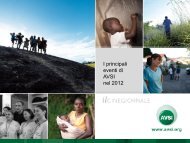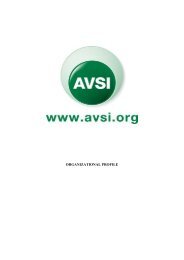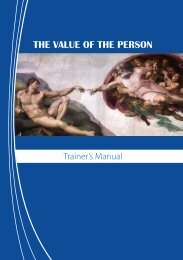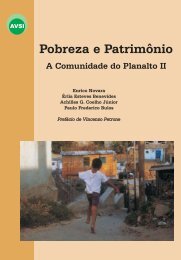AVSI South Sudan
AVSI South Sudan
AVSI South Sudan
- No tags were found...
Create successful ePaper yourself
Turn your PDF publications into a flip-book with our unique Google optimized e-Paper software.
<strong>AVSI</strong> <strong>South</strong> <strong>Sudan</strong>Context, Projects andPerspectives
Areas and Sectors ofIntervention
Key Facts in Education<strong>South</strong> <strong>Sudan</strong> has some of the world’s worst indicators for education. Among theheadlines:• There are in excess of 1.3 million primary school age children out of school. <strong>South</strong><strong>Sudan</strong> stands second-to-bottom in the world ranking for net enrolment in primaryeducation — and bottom of the world league table for enrolment in secondaryeducation.• Young girls in <strong>South</strong> <strong>Sudan</strong> face extreme disadvantages in education.Girls are lesslikely l to enter school, more likely l to drop out, and there are just 400 in the last gradeof secondary education. Today, a young girl in <strong>South</strong> <strong>Sudan</strong> is three times more likelyto die in pregnancy or childbirth than to reach grade 8.• There are acute shortages of trained teachers. The ratio of pupils to qualified teachersaverages 100:1, but is double that level in some states. Just 12% of teachers arefemales, which reinforces gender inequalities.• Textbooks are in short-supply. There is just one English and math book for every fourstudents, which hampers effective learning.• The school infrastructure is in a weak state. Despite a major drive to build newclassrooms most children are still learning under tents, in the open air, or in semi-permanent structures. t Around one-third of <strong>South</strong> <strong>Sudan</strong>’s schools do not have safedrinking water, half are without access to latrines, and there is limited access to healthcentres.
Deep inequality
Education in <strong>South</strong> <strong>Sudan</strong> (1)In the education sector, primary school enrolment has quadrupled d from 400,000000in 2006 to 1.3 million in 2009 and the number of primary schools has increasedby 20 percent, although booming enrolment has increased the student-to-classroom ratio to 248:1. A secondary school has been built in each state and asecondary school curriculum was aunched in 2007.Despite the importance of the social sectors, the resources allocated to health,education and social protection are well below regional norms. Fourteen percentof the government budget is allocated for health, education and social services,while the security sector receives nearly two and half times that amount.During the Interim period, development partners and NGOs have supported thedelivery of basic services in health and education at the state and local levels.This will continue throughout the SSDP period, but the delivery models willgradually shift from projects to basket funding and possibly budget support toenable the government to increasingly assume more responsibility for theexpanded service delivery in these key sectors.
Education in <strong>South</strong> <strong>Sudan</strong> (2)
Education in <strong>South</strong> <strong>Sudan</strong> (3)Relevant Authority:National Level:• Ministry of Education - Minister: Michael Milli Hussein• Ministry of Higher Education, Science & Technology - Minister: JosephUkelState Level:• State Ministry of Education: Minister and Director GeneralReference Paper:• <strong>South</strong> <strong>Sudan</strong> Development Plan 2011-2013– Social and Human Development Pillar, Programme Priorities:• Expanding the number and improving the quality of teachers• Expanding access to General Education• Building a better future: Education in an independent d <strong>South</strong> <strong>Sudan</strong>(UNESCO –EFAGMR, Policy Paper 2011)Th G t f th R bli f S th S d ill k t it blThe Government of the Republic of <strong>South</strong> <strong>Sudan</strong> will work to ensure equitableparticipation in a rapidly expanding and quality education system, geared topromoting sustainable development throughout <strong>South</strong> <strong>Sudan</strong>.
Geography of <strong>AVSI</strong> Education
<strong>AVSI</strong> Education ObjectivesIn line with the eGovernment e poga programmepriorities, <strong>AVSI</strong> decided to focus on twomain lines:• Improving education quality by facilitating teachers togain more expertise and qualification (UNISUD,UNICEF, MAE & UNOPS)• Expanding access to primary education with aparticular focus on girls (UNOPS, MAE & UNICEF)• Providing youth and adolescent with professionaltraining opportunities, in order to enhance thelivelihood of their households (FSTP)
Overview on our educationprojects• Food Security and Livelihood advancement in Torit and Ikotos Counties,Eastern Equatoria State (EU, in consortium with CRS)• Education Emergency in <strong>South</strong> <strong>Sudan</strong>: support and access to primaryEducation in Ikwoto and Torit County - Eastern Equatoria State, <strong>South</strong><strong>Sudan</strong> (MAE)• Saint Mary’s University (Private Funds, in collaboration with OVCI)• Nutrition, Education, Water, Sanitation and Health through PrimarySchool in Ikwoto and Torit Counties (UNICEF and DFID)• Support to Primary Education in <strong>South</strong> <strong>Sudan</strong> (UNOPS)
Livelihood (Vocational and Life Skill Education)Project: Food Security and Livelihood advancement in Hiyala and Ikotos Counties,Eastern Equatoria State (EU, in consortium with CRS)Duration: 3 years (until April 2013) - 536.113 €Overall Objective: to engage communities to meet their long-term food security andlivelihood needs to foster sustainable socio-economic developmentActivities: Establishment and management of two community-based Life SkillsCenters in Imotong and Hiyala; functional Adult Literacy classes; business skillstraining; vocational skills training (tailoring, carpentry and bricklaying); capacitybuilding of teachers, community management bodies, and local governmentauthorities.Beneficiaries: 900 vocational training graduates benefit from Business Skill training(BST) and start up business skill; 360 household beneficiaries trained on AdultLiteracyChallenges: Howtocapitalize this experience after the end of the project. Livelihoodrepresents the main sector for developing local productive capacities. For such reason<strong>AVSI</strong> <strong>South</strong> <strong>Sudan</strong> wants to strengthen its presence in the sector in line with its overallstrategy of intervention
MAEProject: Education Emergency in <strong>South</strong> <strong>Sudan</strong>: support and access to primaryEducation in Ikwoto and Torit County - Eastern Equatoria State, <strong>South</strong> <strong>Sudan</strong> (MAE)Duration: 1 year (from April 2012) - 518.000 € (269.890 MAE contribution tib ti + 235.310310<strong>AVSI</strong> contribution).<strong>AVSI</strong> contribution: Distant Support ProgrammeOverall Objective: to improve education opportunities, increasing the access toeducation, particularly for vulnerable beneficiaries, and improving the quality of teachingActivities: construction of classrooms; construction and maintenance of boreholes;furniture of scholastic materials; support to vulnerable students; trainings on nutritionand sanitation best practices; trainings and sensitization on HIV/AIDS prevention;specific trainings and capacity building for teachers, social workers, PTAs and localgovernment representatives.In order to guarantee a complete package of assistance to the schools where weintervene with MAE and DSP, these projects have been integrated with other fundscoming from Cooperazione Decentrata (Provincia di Bolzano)Beneficiaries: 4.000 (direct), 50.000 (indirect)
MAEChallenges:• Strengthening our collaboration with PCE for training of teachers, socialworkers and parents• Need to define in a more efficient and systematic way our support andcollaboration with St. Kizito primary school in Isohe, the school mostbenefiting from our Education interventions in EES (weakness of our majorpartner, CDoT, in charge of this school, and lack of management skills ofSt. Kizito’s staff). This will be possible only through a deeper presence of<strong>AVSI</strong> within the school (capacity building)
St. Mary’s UniversityProject: Saint Mary’s UniversityDuration: 3 years (until 2013) – 514.521 USDOverall Objective: Construction of the College of Education within the SaintMary’s University of Juba and organization of courses and training for thestudents of the College of EducationChallenges:• Importance of this project in order to show our expertise and skills in Educationwhich remains one of our main sectors of intervention in <strong>South</strong> <strong>Sudan</strong>.• The involvement of PCE is fundamental in order to offer an importantcontribution in terms of Education not only to the Archdiocese but also at theMinistry level. If we want to have a word to say at a higher level in terms ofEducation, this is an opportunity not to be missed especially now thateverything has still to be defined in <strong>South</strong> <strong>Sudan</strong>• Critical issue: only private funds• The possibility to have an office in Juba, where all the main donors,organizations and ministries i i are based, will definitively iti contribute tib t to ourvisibility in <strong>South</strong> <strong>Sudan</strong>
UNOPSProject: Support to Primary Education in <strong>South</strong> <strong>Sudan</strong> (UNOPS)Duration: 1 year (March 2012 - February 2013) – 212.000$Overall Objective: increase the access and quality of education especially forgirls through involving community participation in 4 schools in Eastern EquatoriaStateActivities: Training of teachers through the guidance of the teachers trainers forone year in-service training/support; development of teaching materials andtools; meetings, workshops and trainings for communities, teachers and PTAson management and maintenance of schools, agricultural activities andimportance of girls educationBeneficiaries: 1.600 (direct), 3.700 (indirect)Challenges: one of the selected schools is in Kapoeta <strong>South</strong> (Kapoeta County),outside our traditional area of intervention (Ikwoto and Torit Counties). This is achance to consolidate our presence in Eastern Equatoria State as one of themajor actors in Education
Nutrition Education, Water, Sanitation andHealth - 1Project: Nutrition, Education, Water, Sanitation and Health through PrimarySchool in Ikwotos and Torit Counties - NEWSH + Improve Child FriendlySchools in Torit County through Community Development and Girls Education(UNICEF and DFID)Duration: March 2012 – February, 2.5 million dollarsOverall Objective: to enable children and young people to access qualitybasic services. Such objective will be pursued using primary schools asentry points to provide access to education, safe water and sanitation,HIV/AIDS prevention, and health, with a strong impact on the localcommunities where these schools are located.Activities:Health and Nutrition:• Outreach Activities (EPI for 10,293 children, ANC for 1960 women, Deworming,malnutrition screening) for 6 PHCUs• HIV/AIDS awareness training
Wash:Nutrition Education, Water, Sanitation andHealth - 2• Construction of water points, sanitation facilities and harvesting ferrocement tanks• Establishment of a school hygiene and sanitation monitoring system• Training of Water Committees• Establishment of School Hygiene Clubs and training of PTAsEducation• Distribution of scholastic and learning aid• Training of teachers and PTAs in school management and code of conduct• Mine Risk education training• Establishment of multifunctional clubs• Drawing and Drama competition on peace building and problems raised by the verypupilsp
Nutrition Education, Water, Sanitation andHealth - 3DFID Component: <strong>AVSI</strong> will implement the model of child friendlyschools in two of the selected schools in Torit County. The aim of the actionis to create an inclusive and protective environment in which children canexpress themselves in a conductive way. Teachers and parents will play anactive role in promoting school enrollment with particular focus on girls.<strong>AVSI</strong> <strong>South</strong> <strong>Sudan</strong> will continue collaborating with the PCE to implementsome of the trainings foreseen by our intervention (psycho-social, familycounseling, child participation, child centered active learn methodologies inthe classroom, alternative disciplinary approaches)Beneficiaries: 52,000 (target communities)Challenges: Important chance to show to this important donor our capacityto manage and implement a complicated multi-sectors project thanks toour consolidated presence in Eastern Equatoria. Possibility to obtain otherfunds for other Unicef projects in the same area of intervention
Health & Nutrition in <strong>South</strong><strong>Sudan</strong>A distinct shortage of skilled health workers and health facilities has resultedin largepopulations being denied access to healthcare : 87% of thepopulation doesnot have access to a healthcare facility [SSDP,2009]The high cost of healthcare delivery has resulted in an inefficient provision ofservices,reducing the ability of the population from engaging in productive activity.Poor health contributes significantly to poverty in <strong>South</strong>ern <strong>Sudan</strong> and thecurrentindicators for health are amongst the worst in the world.
Key facts• Only 17.5 per cent of children are fully immunized i with ihthe basic set of vaccinationsi• [SHHS, 2006]• In some States, the prevalence of underweight and stunted children is as high as 40 per cent[SHHS, 2006].
Health MOH targets• Health: Maternal and under-five mortality, particularly l in rural areas, will decline by as muchas 20 percent within the first three years of statehood. Baseline: Maternal mortality rate in 2006was 2,054 deaths for every 100,000 live births. Under-five mortality in 2009 was 135 per 1,000live births.• The Government of the Republic of <strong>South</strong> <strong>Sudan</strong> will work to equitably increase utilisation ofquality basic health and HIV/AIDS services throughout <strong>South</strong> <strong>Sudan</strong>.• The sector objective is grounded in the Interim Constitution of <strong>South</strong>ern <strong>Sudan</strong>, which directs alllevels of government to promote public health, establish basic health facilities and provide freeprimary healthcare for all citizens. The Child Act of 2008 further establishes the right of everychild to free basic health care and to immunisation.• As a major priority, the health sector has set a target of reducing maternal and underfive mortality,particularly in rural areas, by as much as 20 percent within the first three years of statehood. Thispriority will build on <strong>South</strong> <strong>Sudan</strong>’s success to date in cutting the transmission of deadly diseasesand expanding vaccination coverage.• The health sector plays a central role in improving the productivity of the national labour force.Safeguarding the health status of the population is recognised as a pre-requisite for all socialand human development.“ There are only two things here: life and death, without life nothing can be done that is whyyou should access our outreach health services”Dwamoi, PHCC Supervisor <strong>AVSI</strong> Isohe.
Health MOH targets
Government Health programspriorities (SSDP-2011)• Increasing access to basic health services andhealth promotion.• Strengthening human resources in the healthsector.• Expanding the pharmaceutical and medicalequipment supply chains.• Strengthening the health management system• Strengthening provision of HIV/AIDS services.
Water and Sanitation• Access to safe and reliable water sources in <strong>South</strong>ern<strong>Sudan</strong> is improving slowly, despite the fallout from thecivil war that destroyed many water facilities.However, only 49.5% per cent of the populationcurrently have safe access to improved water sources [5thPHC,2008]; andOnly 23.9% per cent of <strong>South</strong>ern <strong>Sudan</strong> populationhas access to a toilet facility [5th PHC,2008]
Health AuthoritiesThe National Health System is made up of the public and private sectors :The public sector includes all Government health institutions under the Ministries of Health (MoH-GoSS and SMoHs) and other ministries (especially Defence and Internal Affairs).The private health delivery system consists of Non Governmental Organizations (NGOs) (privatenot for profit), private health practitioners (PHP), the traditional healers and the communities.Health sector organization and management in <strong>South</strong>ern <strong>Sudan</strong>The Ministry of Health-GoSS provides leadership for the health sector. It takes a leading role andresponsibility in the delivery of health services to the people of <strong>South</strong>ern <strong>Sudan</strong>.The management and provision of health services in <strong>South</strong>ern <strong>Sudan</strong> has been decentralized with theState Ministries of Health (SMoHs) and County Health Departments (CHDs) playing a key rolein the delivery and management of health services.The Interim Constitution of <strong>South</strong>ern <strong>Sudan</strong>, 2005 defines the three levels of government and TheThe Interim Constitution of <strong>South</strong>ern <strong>Sudan</strong>, 2005 defines the three levels of government and TheHealth Policy (2007-2011) details the roles of Ministries of Health at different levels of governmentand health system
What is BPHS• The health h services in <strong>South</strong>ern <strong>Sudan</strong>, as broadly defined d in theBasic Package of Health Services, are categorized under fiveclusters, namely:• Health Promotion and Disease Prevention• Maternal. Neonatal, Child, Reproductive and Nutrition Services• Control of Communicable Diseases• Control of Non Communicable Diseases• Essential Hospital Services/Clinical ServicesIt is estimated that currently only 25 percent of the population in<strong>South</strong>ern <strong>Sudan</strong> has access to health services.
Current <strong>AVSI</strong> Health ProjectsWhat:1. BSF5 1 st January 2012 – 31 st December20122. UNICEF 1 st February 2012 – 31 st January2014Where:Ikotos County, Eastern Equatoria State.
Basic Services FundProject: Support to Integrated Health Care System in Ikwoto County, EES,<strong>South</strong>ern <strong>Sudan</strong> -Duration: 1 year – 600.000GBP000GBPOverall objective: To reduce mortality and morbidity in Eastern Equatoria Statethrough increased coverage of quality health services in Ikwoto CountyActivities: supervision and coordination support of the selected facilities (7PHCUs and 3 PHCCs), outreach activities, supplies of drugs and equipment,maintenance of the facilities, capacity building and overall logistic support to thecounty health system (in partnership with DoT)Beneficiaries: 87,188 (target population)Challenges:• This action is framed within the perspective of the Health Pooled Fund startingfrom 2013, which foresees the coverage of a whole County by a single NGO, witha strong community engagement. <strong>AVSI</strong> will become the health leading NGO forIkwoto County. We have to prove our capacity to do it properly.• Weakness of our only partner (CDoT) in EES and need to improve its capacity toact as a reliable and proactive health partner• Operating Theatre in Isohe to be completed and operative as soon as possible(submission of a proposal to Provincia di Bolzano)• Health Coordinator to be recruited as soon as possible (fundamental in order toconsolidate our health skills and expertise and to be ready for the HPF in 2013 ).BUT this recruitment seems complicated
BSF5StateEastern Equatoria StateCountyIkwotoPayamsChahariChorokolIkwoto CentralImotongGrant Amount requested in GBP:Total Project Budget Amount Requested Amount requested aspercentage of Total Budget(%)GBP 599,950.25 GBP 599,950.25 % 100Continued provision of basic package of health:<strong>AVSI</strong> continues supporting health facilities: St. Theresa Clinic in Isohe, plus the 6 PHCUs of Lobira, Chahari, Mangalla, Chorokol, Lodwaraand Ohorhore.Welcoming the proposal jointly raised by the County and BSF team, <strong>AVSI</strong> also increased by 3 the total number HF supported under theprevious BSF/DFID grant, adding:‣Imotong PHCC‣Ikotos PHCC‣Lorima PHCU•Support in-service and formal training of health workers within PHCCs and PHCUs: <strong>AVSI</strong> will continue and will increase its program of inserviceand formal training carried out in the supported 10 health facilities•Support SMoH in strengthening County Health Departments and community capacities for the supervision of health services: <strong>AVSI</strong> isalready carrying out supervision of the supported health facilities in conjunction with Ikwoto County Health Department on regular basis•Increased awareness of communities on basic health: <strong>AVSI</strong> is expecting to contribute to increase general awareness on health andsanitation within Ikwoto County by following up its sensitization sessions carried out throughout the previous BSF phaseStrengthening of Governance structures such as the County health department, village/bomas health committees: <strong>AVSI</strong> will work closely withIkwoto County Health Department in order to strengthen its capacity and managerial skills.
•Description of activities by result and sector:General Objective:To reduce mortality and morbidity in Eastern Equatoria State through increased coverage of quality health services in Ikwoto County.Output 1. Strengthened capacity of 3 PHCCs and 7 PHCUs to deliver basic health services.Activities•Support and supervision of 3 PHCCs and 7 PHCUs:•Support for 23 staff salaries of 3 PHCCs through the CDoT and SMoH:•Support for incentives to the workers of 7 PHCUs:•Maintenance and Rehabilitation works in 3 PHCCs and 7 PHCUs•Provision of essential drugs and laboratory reagents to 10 health facilities:•Provision of essential medical and laboratory equipment to 10 health facilities:•Provision of facility furniture and medical stationery to 10 health facilities:•Support for St. Theresa PHCC generator running costs:•ProvisionP i i of in-servicei healthtraining i to 10 healthfacilitiesOutput 2: Increased adoption of preventive health practices among targeted population: Activities•Outreach activity:•Distribution of sanitation kits for pregnant mothers:•Formation and training of village health committees:•Support St. Theresa, Ikotos and Imotong PHCC to deliver preventive health services:•Production of relevant IEC material (HIV awareness and nutrition)Output 3: Strengthened decentralized Government/ SMoH capacity to manage basic health services system.Activities•Conduct monthly sector coordination meetings at County and State level;•Follow-Up on Water and Sanitation Committees:•County Hygiene Promoter training..•Refresh training for WSSC:
Consultations and Preventive ActivitiesTARGETHealth Targets Beneficiaries Males Beneficiaries Females Total BeneficiariesBSF 5 - Support to Integrated Health Care System in IkwotoCounty, EES, <strong>South</strong>ern <strong>Sudan</strong> – Target and AchievementsConsultations < 5yr 14000 14000 28,000Consultations > 5yr 18,000 20,000 38,000Women attending 1 ante‐natal natal care visits 2700 2700 2,700Women attending 4 ante‐natal care visits 400 400Births attended by skilled health workers 400 400Under 1s completing DPT 3 200 200 400Children de‐wormed 1500 1500 3,000Vitamin A for lactating mothers 700 700Vitamin A children < 5 700 700 1,400Measles 250 250 500BCG Vaccine (TB) 600 600 1200OPV Polio (0) 1000 1000 2000OPV Polio 3 700 700 1400Tetanus Toxide 1 2,000 2000Tetanus Toxide >3 800 800
Overview Of FundingEnvironmentUntil recently, it was expected that following independence in July2011, <strong>South</strong> <strong>Sudan</strong> would be transitioning to a ‘post-conflict’setting, and hence funding modalities would adjust to a moredevelopmental framework. Much of the planning by donors andgovernment during 2011 seems to have been based on thisassumption.However, events of recent weeks (including growing humanitarianneeds in various parts of the country, the expected impact ongovernment finances of the oil production shutdown, and the currenthostilities along the northern border) have raised questions aboutthis transition. It is currently unclear to what extent donors willcontinue with a shift towards more developmental fundingmodalities, or whether there will be a shift towards humanitarianifunding once again.
Where are we going?g• Eastern Equatoria represents an exception considering the present generalsituation in <strong>South</strong> <strong>Sudan</strong> (widespread insecurity in the Northern States –problems with <strong>Sudan</strong> – and in other States – interethnic problems, Lou Nuer-Mourle conflict and heavy SAF bombing in Unity and Northern Bahr-el-Gazel)• This does not necessarily mean that <strong>AVSI</strong> has to change its area and sectorsof intervention (running after emergency funds)• Instead, it means that now, more than before, <strong>AVSI</strong> is reinforcing itspresence in Eastern Equatoria, as a major and consolidated actor inEducation and Health, which are our main sectors of intervention. Theprojects which we are implementing at the moment (especially BSF forHealth and Unicef for Education) go exactly in this direction.• <strong>AVSI</strong> has now to show and demonstrate its ability, capacity and expertise toguarantee continuity and stability in all our interventions (donors havealready recognized it. We are now co-leader with UNICEF in EES forEducation in Emergency Cluster )
Where are we going?• Until now, our structure has relied on <strong>AVSI</strong> Uganda in terms of financialand logistical management.• The context has deeply changed: procurement process can be done in loco,qualified staff should be preferably <strong>South</strong> <strong>Sudan</strong>ese, banks are nowoperative.• Thee current independency process of <strong>AVSI</strong> <strong>South</strong> <strong>Sudan</strong> is the result ofthis changing context. . This process will demand a strong effort from all ourstructure (Operations Manageralready operative in Juba) throughout allthe year• Now that new projects start, our three operative bases (Isohe, Torit andJuba) need to be efficiently reorganized in order to handle these newchallenges
Do we allow the subject togrow?• <strong>AVSI</strong> Staff:• How do we relate to our staff?– The organizational context of <strong>AVSI</strong> in <strong>South</strong> <strong>Sudan</strong> is still quite young. This forcesthe staff to keep on diversifying their duties and expand the time devoted to work.This can represent a positive challenge to the subject, forcing it to have moreconsciousness of itself. At the same time, it can also prevent it from being properlycultivated.– Exploit the talents of one person at his/her best, especially by fitting his/her desiresto the needs of the organization
Do we allow the subject togrow?• Beneficiaries:How do we relate to our beneficiaries?– Since the context defines the kind of intervention, <strong>AVSI</strong> is currently carrying outextremely basic services interventions. Nevertheless, we believe suchinterventions are fundamental as they represent the foundation for theconstruction of fruitful relationships between <strong>AVSI</strong> and its recipients.– <strong>South</strong> <strong>Sudan</strong>ese context does not represent a limit to growth but it represents anopportunity in terms of helping people to define their development– <strong>AVSI</strong> interventions in health and education sector are going exactly in thisdirection: we support the subject by uplifting the burden that is caused by lack ofservices and that would prevent the subject from growing.– FSTP project is the first step in <strong>AVSI</strong> <strong>South</strong> <strong>Sudan</strong> to really empower the subjectto built its own resilience
Starting point and directionAdequate?• We believe that from the dialogue of different entities i (i.e. Expats and local l staff, LocalAuthorities and Communities) the best and most effective program activities can flourish.• We don’t run after funds, we choose what htis worth and relevant tto be pursued.• How to think bigger and at the same time to maintain our method?We will continue:– Working with communities and local authorities in the identification of needs, and inthe definition of priorities and interventions entions (centrality of person, doing with andbeneficiary-driven interventions)– Starting from what already exists (starting from the positive) Unicef: schools asstarting point of our interventions BSF: taking over some PHCUs and PHCCs whichwere before supported by other actors– Working through partners (CDoT and St.Joseph Kitgum) and attempt to define withCDoT a strategy to make it more responsible and proactive but also possibility to findnew synergies with new partners
MILANO<strong>AVSI</strong>, since 1972 promoting the global dignity of every personVia Legnone, 4<strong>AVSI</strong> Foundation is a global non-governmental organization based in Italy. Its mission is to support 20158 Milanohuman development in developing countries according to the social teaching of the Catholic Church: every Tel.: +39.02.6749881988person, as a unique being, should not be reduced to a number within anonymous categories like “the poor,the sick, the disabled”. Furthermore, any person and any community represent a resource, regardless of theirvulnerability. This is why <strong>AVSI</strong> works to help people in becoming aware of their own value and dignity.<strong>AVSI</strong> is involved in more than 100 cooperation projects in 38 developing countries worldwide in Africa,Latin America and the Caribbean, Eastern Europe, Middle East and Asia. <strong>AVSI</strong>'s main activity areas aresocio-education, urban development, healthcare, labour, agriculture, food security and water, energy andenvironment, humanitarian emergency and migration, reaching more than 4.000.000 direct beneficiaries.The personnel implementing these activities included around 1.450 persons (100 expatriated staff,1.300 local staff and 50 in the headquarters). A network of 1.000 volunteers in Italy, involved in activitiesof fundraising in support of <strong>AVSI</strong>, meets in a year about 400.000 people. In 2011, <strong>AVSI</strong> receivedcontributions for a total amount of around 28 million euros (around 35 million euros is the amount raisede, 4by <strong>AVSI</strong>-system in the world), both from institutional and private donors. Between its major institutionaldonors the Ministry of Foreign Affairs, the European Union, USAID, FAO, UNICEF, the World Bank.20158 MilanoTel.: +39.02.6749881Fax: +39.02.6700 are the partners of <strong>AVSI</strong> in the world (NGOs, public and local institutions, CBOs, informal groups,enterprises etc.). More than 60 organizations among them set up an informal “<strong>AVSI</strong> network”, whichworks systematically, with the coordination of the Knowledge Centre, on the implementation of projects,sharing methods and experiences, discussing development issues, enhancing capacities in organizational,managing and contents. The network includes the 27 founding members and participating members of <strong>AVSI</strong>,but also partners. A network bound by operative friendship.The Annual Report, certified by a major auditing firm, is available on <strong>AVSI</strong> website.<strong>AVSI</strong> has been recognized since 1973 by the Italian Ministry of Foreign Affairs as a non-governmentalorganization for international cooperation (NGOs); is registered as a PVO with the Agency for InternationalDevelopment of the United States (USAID) and holds General Consultative status with the UN Economic andSocial Council (ECOSOC) in New York and UN Children's Fund (UNICEF), is an accredited participant of theUN Global Compact and is recognized on the NGO Special List of the International Labor Organization(ILO).<strong>AVSI</strong> i l i d NGO f i t ti l ti b th E U i d i<strong>AVSI</strong> is also recognized as an NGO for international cooperation by the European Union and isauthorized by the Italian Government for international adoptions.<strong>AVSI</strong> holds in Italy up to 10% of private donations for operating costs.Fax: +39.02.67490056E-mail: milano@avsi.orgCESENAvia Padre Vicinioda Sarsina 21647521 CesenaTel.:+39.0547.360811 fax:+39.0547.611290E-mail: cesena@avsi.org<strong>AVSI</strong>-USAwww.avsi-usa.orgHeadquarter:125 Maiden Lane15th floorNew York - NY 10038DC Office:529 14th Street NWSuite 994Washington, DC 20045Ph/fax:+1 (202) 429-90099009infoavsi-usa@avsi.org


